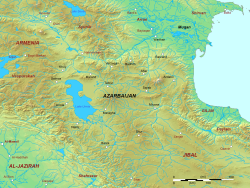Abu Mansur Wahsudan
Abu Mansur Wahsudan (also spelled Vahsudan; Persian: ابو منصور وهسودان) was the penultimate Rawadid amir (ruler) of Azarbaijan from 1025 to 1058/59.
[1] With the assistance of his Kurdish neighbours, he initially contained the attacks of migrating Turkmen tribes, but was eventually forced to acknowledge the authority of the Seljuk ruler Tughril (r. 1037–1063) in 1054.
The Ottoman historian Münejjim Bashi (d. 1702), who based his work on the now lost 12th century Ta'rikh al-Bab wa'l-Abwab, reports that Abu'l-Hayja Mamlan I died in 1001.
The modern historian Andrew Peacock suggests that the Rawadid kingdom was divided between Wahsudan and Abu Nasr Husayn II, or that the latter's reign was short-lived.
[2] In contrast to the other relatively obscure Rawadid amirs, Wahsudan's reign is better attested because of the preservation of the sixty panegyric qasidas (a form of poetry) composed by the Persian poet Qatran Tabrizi.
At an unspecified date, Wahsudan sent a large force led by his son Abu Nasr Mamlan, who was accompanied by Qatran, against the Ispahbadh of Mughan.
[2][4] Wahsudan had an uneasy relationship with his sister's son Abu'l-Hayja ibn Rabib al-Dawla, who was the leader of the Hadhabani tribe, as well as the ruler of Urmia and the fortress of Barkari.
[2][4] The eviction of the Iraqiya from Azarbaijan allowed Wahsudan to improve his relations with the neighbouring Shaddadids, as he went to their capital of Ganja in person and visited their ruler Abu'l-Hasan Lashkari (r. 1034–1049).
Tughril's name was placed in the khutba (Friday prayer), while a son of Wahsudan, possibly Abu'l-Hayja Manuchihr, was sent as a Seljuk hostage to Khurasan.
